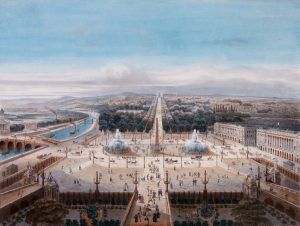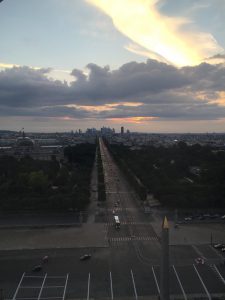With good weather and summer’s long-awaited arrival, many of us will be traveling near and far to new and exciting places. Traveling today is still frustrating, even with fast transportation and constant access to technology, so I was very curious to find out what obstacles our ancestors faced centuries ago.
Many diaries have been digitized and added to the NEHGS Digital Collections on the American Ancestors website. In this new grouping I found two travel diaries that sparked my interest on what the similarities and differences of the diarists’ travels in the nineteenth century and my own in the twenty-first century might be.
The first diary, written in 1859 by a student named Francisco Weld Evans,[1] describes in detail his journey from Cambridge, Massachusetts, to Paris, France, as well as his everyday routine on the various excursions of the trip. The second diary is authored by Richard Sullivan,[2] who departs from New York and travels all over Europe in the years 1872–78.
Traveling in the nineteenth century was undeniably different, as it was a time of limited communication and transportation. In his diary, Evans describes his day-to-day efforts in gathering supplies leading up to the day he departs on his journey. This includes packing his trunk, ordering a passport, solidifying all his accounts abroad, as well as preparing his accommodations in both England and France. Planning well in advance was especially important, as there was such limited means of communication, with letters being the only way to reach family and friends. If a mishap occurred, it was up to you to figure it out on the spot. For example, when Sullivan’s luggage was sent to Paris rather than to Sens, he had to skip his original plans and instead travel to Paris himself to retrieve his belongings that day.
If a mishap occurred, it was up to you to figure it out on the spot.
One of the biggest differences between travel then and now is the cost and the transportation used. In his 1878 diary, Sullivan describes having taken boats, carriages, and railways all across England, France, and Italy. Today, with innovative transportation such as the Eurostar Chunnel, travel no longer takes days or months, but hours. In addition, boats are used less often as public transportation today, whereas in the nineteenth century they were the primary mode of getting from one place to another.
In terms of the cost of transportation, Evans writes that, “From London to Paris [the] fare is 3 pounds, 1 shilling, and 6 pence,” compared to train prices now that range from about US$80–200. While the nineteenth century numbers at first seem shockingly low, 3 pounds in 1859 would actually have the purchasing power of about 375 pounds today.[3] This is relevant, as during the 1800s it was often only wealthy citizens who took part in trips like these as it required a certain amount of money and education. These European trips revolved around young, white men, like Evans and Sullivan, gathering at elegant places such as the Palais Royale (mentioned by both authors). As it is described in Evans’ diary, the daily routine revolved predominantly around what tutor-administered lessons were taught that day, whether it was French, chemistry, etc.
Many men coming of age at this time and earlier did what was called the “Grand Tour”[4] and traveled around Europe in order to gain knowledge and eventually settle into their place in society. This can only be compared to what study abroad is to college students today, in which they travel around Europe while taking classes at a university in one country. Nowadays, travel is comparatively more accessible, in terms of quick transportation as well as the fact that vacations and educational opportunities are open to people from many, though certainly not all, socio-economic backgrounds.
However different Evans’ and Sullivan’s experiences seemed from my own and the average modern-day traveler, travel is still relatively similar today as it was then. Travelers today and in the nineteenth century made a point to see the same sights and attractions, such as the Champs-Élysées, the Louvre, and Versailles.
Travel in any time period can bring a person into contact with unprecedented and unpredictable conflict. In 1859, the Second Italian War of Independence was taking place, and Evans describes having been awoken by “the cannons of the Invalides” on June 25. Evans also marks important dates in history, writing at the top of the 11 July 1859 page that the “peace with Austria [was] signed today,” meaning that the Conference of Villafranca – between French emperor Napoleon III and Emperor Francis Joseph I of Austria, which ended the Franco-Piedmontese war against Austria[5] – had just occurred. This was an extremely important turning point as it marked the beginning of Italy's unification under Piedmontese leadership.
Travel in any time period can bring a person into contact with unprecedented and unpredictable conflict.
Today, in a similar way, civil wars and terror attacks add an element of fear when traveling anywhere in the world, as conflict cannot always be anticipated. For example, while I was visiting France in 2016, the Istanbul airport attacks occurred, with media reports shaking the public almost as much as the war cannons shook Evans in 1859.
I love travel for all the culture, food, and history it has to offer. Francisco Weld Evans and Richard Sullivan helped me to see the places I have traveled to through nineteenth-century glasses. I hope that history like this continues to flow through the highways and back roads, hidden spots and tourist traps of countries everywhere and that travel continues to be an integral part of society, no matter what year it is.
*
Please note: you can view these diaries and more in the Family and Personal Papers collection.Source:
Notes
[1] Diary of Francisco Weld Evans, Mss 661, R. Stanton Avery Special Collections, New England Historic Genealogical Society, online at DigitalCollections.AmericanAncestors.org.
[2] Diary of Richard Sullivan, Mss 654, R. Stanton Avery Special Collections, New England Historic Genealogical Society, online at DigitalCollections.AmericanAncestors.org.
[3] "Inflation Rate between 1800-2017. UK Inflation Calculator." £1 in 1800 → 2017 | UK Inflation Calculator. Accessed 24 June 2019.
[4] The Grand Tour. GrandTours, Inc. Accessed 18 June 2019.
[5] "Conference of Villafranca." Encyclopædia Britannica. Accessed 24 June 2019.
Share this:

About Lydia Cheever
Lydia Cheever is an intern at the NEHGS Library. She is a student at Marist College, where her major is history education. Lydia plans to become a high-school history teacher. She is interested in all things historical, particularly the period of World War II.View all posts by Lydia Cheever →

